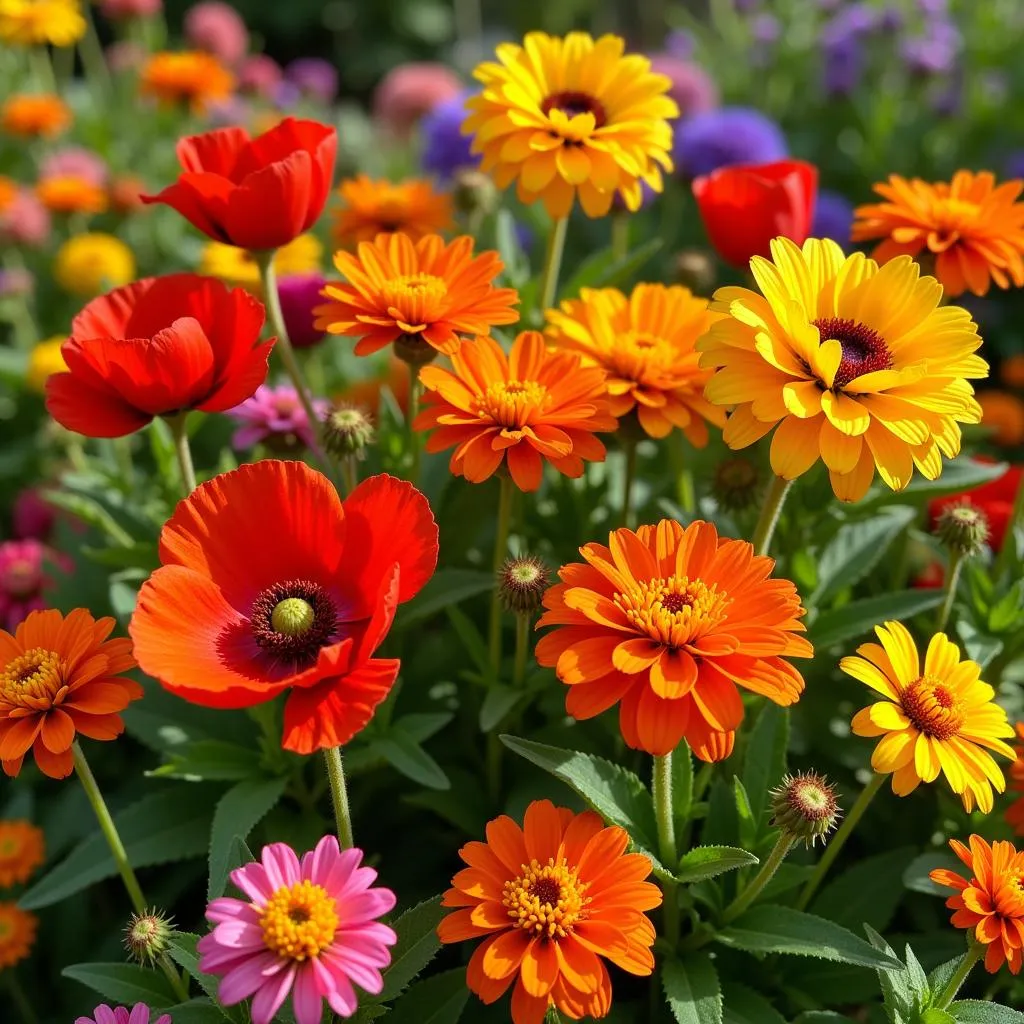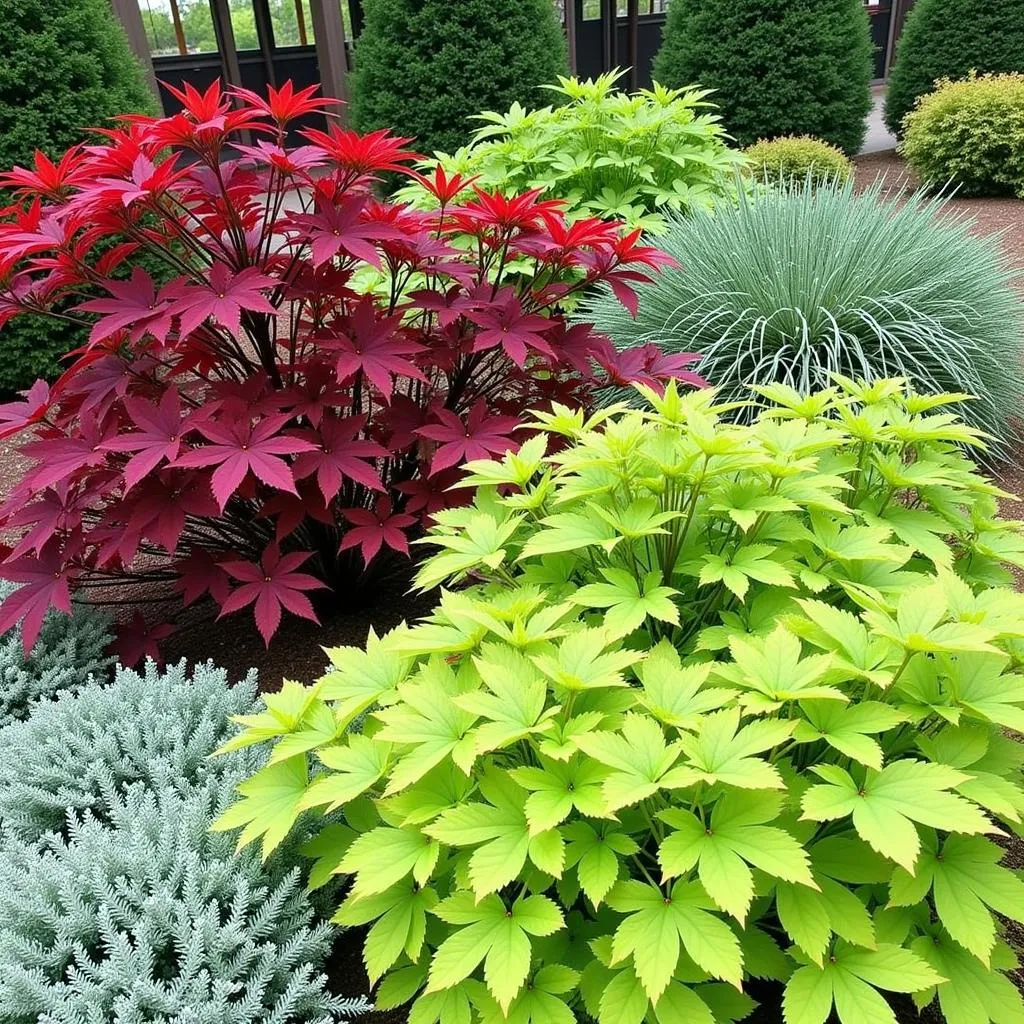Choosing the right colors for your landscape can feel overwhelming. From vibrant blooms to subtle foliage, the options are endless. But fear not, color doesn’t have to be a puzzle. By understanding the basics and following a few simple guidelines, you can create a landscape that’s as visually appealing as it is harmonious.
The Language of Color in Landscaping
Just like in interior design, colors play a crucial role in setting the mood and feel of your outdoor space.
-
Warm colors like reds, oranges, and yellows bring energy and excitement. They tend to advance visually, making spaces feel cozier. Imagine a fiery sunset reflected in a bed of orange marigolds or a vibrant red maple stealing the show in autumn.
-
Cool colors like blues, greens, and purples evoke a sense of peace and tranquility. They recede visually, making spaces feel larger. Think of a serene water feature surrounded by cool-toned hostas or a pathway lined with lavender leading to a hidden garden nook.
-
Neutral colors like white, gray, and brown provide a calming backdrop for other colors to shine. They help to balance out bolder hues and create a sense of unity. Consider a stone pathway meandering through a lush green lawn or a weathered wooden fence framing a vibrant flower bed.
 Garden with warm color flowers
Garden with warm color flowers
Creating Color Harmony in Your Landscape
The key to a successful landscape design lies in achieving color harmony. Here’s how:
-
Monochromatic Harmony: This involves using different shades and tints of a single color. For instance, a monochromatic blue garden might feature light blue hydrangeas, mid-blue delphiniums, and deep blue salvia.
-
Analogous Harmony: Choose colors that sit next to each other on the color wheel, such as yellow, yellow-green, and green. This creates a natural flow and sense of unity. Picture a landscape transitioning from golden yarrow to lime green ferns to deep green hostas.
-
Complementary Harmony: This involves using colors that are opposite each other on the color wheel, such as red and green or blue and orange. These combinations create a vibrant and energetic feel. Think of a classic rose garden with its red blooms set against a backdrop of lush green foliage.
 Color wheel with examples for garden design
Color wheel with examples for garden design
Beyond the Blooms: Incorporating Color in Unexpected Ways
Remember, color isn’t limited to flowers! Consider these creative ways to infuse color into your landscape:
-
Hardscaping: Patios, walkways, walls, and fences offer an excellent opportunity to introduce color through materials like brick, stone, and stained concrete.
-
Foliage: Don’t underestimate the power of foliage! Many plants offer stunning foliage in shades of green, silver, purple, and even red, providing year-round interest.
-
Water Features: The reflective qualities of water can enhance and amplify the colors in your landscape.
-
Garden Art: Add pops of color and personality with sculptures, birdhouses, or decorative pots.
-
Lighting: Strategically placed landscape lighting can highlight key features and create dramatic effects at night.
 Garden designed with focus on foliage colors
Garden designed with focus on foliage colors
Expert Insight
“When planning your landscape, remember that color is subjective,” says renowned landscape architect, Emily Carter. “There are no strict rules. The most important thing is to choose colors that resonate with you and create a space that brings you joy.”
Bringing Your Vision to Life
By understanding the principles of color theory and exploring the diverse palette nature offers, you can create a landscape that’s both visually stunning and a true reflection of your personal style. Remember, your landscape is a canvas, and you are the artist. Don’t be afraid to experiment and have fun with color!
FAQ
1. What are some good colors for a small garden?
Cool colors like blues and purples can make a small garden feel larger. Opt for plants with a delicate texture and avoid using too many different colors.
2. How can I add year-round color to my landscape?
Incorporate plants with colorful foliage, berries, or bark. Consider evergreens for winter interest and early-blooming bulbs for a touch of spring color.
3. What colors attract butterflies?
Butterflies are attracted to bright colors like red, orange, yellow, and purple. Plant butterfly-friendly flowers in a sunny location.
4. What is the best way to choose a color scheme for my landscape?
Gather inspiration from magazines, online resources, or gardens you admire. Consider your personal preferences and the overall style of your home.
5. Can I mix warm and cool colors in my landscape?
Yes, but do so carefully. Use neutrals to create balance and transitions between warm and cool areas.
Need help designing your dream landscape? Contact us at Phone Number: 0373298888, Email: [email protected] or visit us at 86 Cầu Giấy, Hà Nội. Our team is available 24/7 to assist you.
Explore more color inspiration on our blog:
- Learn how to color rolling hills krita.
- Discover what color is the liberty bell.

